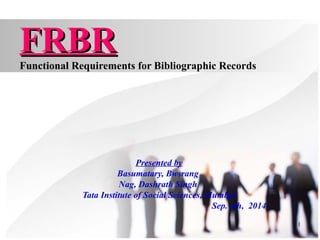
FRBR presentation by Bwsrang Basumatary
- 1. 1 FRBRFRBR Functional Requirements for Bibliographic Records Presented by Basumatary, Bwsrang Nag, Dashrath Singh Tata Institute of Social Sciences, Mumbai Sep. 4th, 2014
- 2. 2 Agendas: What is FRBR ? Basic concept of FRBR FRBR entities FRBR entity relatonship Model Needs of FRBR Benefits of FRBR FRBR and RDA Conclusion
- 3. 3 What is FRBR ? Functional Requirements for Bibliographic Records FRBR developed in a seminar on Bibliographic record held in Stockholm in 1990 A resolution was passed in that seminar a study be commissioned to define the functional requirement of bibliographic record in relation to the variety of users needs and the variety of media A group was formed in 1991 by IFLA. FRBR report was approved in 1997 IFLA Publication group published in 1998 A new conceptual model for bibliographic universe with a strong users focus A conceptual entity relationship model that relates user tasks of retrieval and access in online library catalogue and bibliographic database from a users perspective The purpose of this entity relationship analysis was to discover logical nature of bibliographic data in terms of entity, attributes and relationship
- 4. 4 FRBR basic concept FRBR is entity relationship model Basic concepts : Entity: Key object that users are interested in findings Attributes (data element): Bibliographic data with which entities are associated Relationship: meaningful relationship between two or more entities Fig. 1: relation between one to another entity Example of Relationship
- 5. 5 FRBR entities Ten entity under three groups Group 1: 1. Work 2. Expression 3. Manifestation 4. Item Group 2: 5. Person 6. Corporate Body Group 3: 7. Concept 8. Object 9. Event 10. Place
- 6. 6 FRBR entity relatonship Model Group 1: It is the product of intellectual & artistic endevour Work: a distinct intellectual or artistic creation Expression: The intellectual or artistic realization of a work in some forms (i.e language, alpha numaric, and music) Manifastation: Physical embodiment of an expression,(eg. print publication, CD, DVD) Item: single examlar of manifestation(eg. one copy of book) Fig. Group 1 entity relationshipFig. Group 1 entity relationship Eg. Group 1 entity
- 7. 7 Cont........ Group 2: Those responsible for the intellectual and artistic content Person: name, digignation, date,place of birth etc. eg. William Shakespeare Corporate Body: Institution name, number... eg. Tata Institute of Social Sciences Fig. Group 2 entity relationshipFig. Group 2 entity relationship
- 8. 8 Cont........ Group 3: It is the subject of work Concept: Abstract/ Idea Object: Material thing title of object, date of production Event: Action/ occurance Date, celebrety event Place: Location term for the places Fig. Group 3 entity relationship
- 9. 9 Needs of FRBR Improve the users experience in locating of information Guide systems designs for the future Guide rule makers Cut cost for the description and access to resources in our libraries Position information provides to better operates in the internet environment and beyond To make the catalog work best for patrons. To avoid becoming merginalized by other information discovery services. To encourage redesign of our systems, to move us into liked data information discovery and navigation systems in the internet environment. To make bibliographic description and access data more internationally acceptable.
- 10. 10 Benefits of FRBR Collocation Better organisation to catalogue More option to display identifying elements pathways Essier cataloguing and Circulation Helps upgrade Cataloging Efforts. Achieving higher quality and more effectively shared cataloging efforts with easier maintenance. In the Digital Environment the FRBR helps better manage to the resources. It helps easier integration of resources and systems among libraries and beyond in the digital information environment because it was created considering a wide range of materials, media, and formats such as textual, cartographic, audiovisual, graphic and film.
- 11. 11 Cont........ The FRBR relationships can be used for designing visual tools to facilitate information seeking in the bibliographic universe FRBR opened the road to new method of cataloging/new model of subject cataloging New model of authority data FRBR can contribute toward the future integration of all resources in all of the world's repositories, including libraries, bookstores, music and film archives, publishing houses.
- 12. 12 FRBR and RDA FRBR: Functional Requirements for Bibliographic Records In 1998 FRBR was published by IFLA RDA: Resource Discription and Access FRBR as foundation for RDA 1997 international conference was held in Toronto, Canada for princiles and future development of AACR RDA is the successor of AACR2 2005 name change to RDA, to reflect need to closer align with FRBR and international view (removed anglo amerian) RDA is a set of cataloguig rules based upon the FRBR conceptual model and FRBR principles. In order to better understand RDA we should get a grasp of what FRBR is.
- 13. 13 Conclusion The FRBR conceptual model is an important feature in the library and information science. The FRBR model brought a change in the organization and display of bibliographic records as well as the structure and content of those records. The entity relationship modeling technique on which the FRBR model is based is also being employed to analyze authority data. Cataloging rules are changing, in part in response to the model. The FRBR conceptual model appeals to those whose goal is to make sense of the bibliographic universe Although there are unresolved issues associated with it, the FRBR model still emerges to many to represents a hope for rationalizing and controlling that universe and thereby increasing its usefulness.
- 14. 14 ThanksThanks Basumatary, BwsrangBasumatary, Bwsrang && Nag, Dashrath SinghNag, Dashrath Singh
